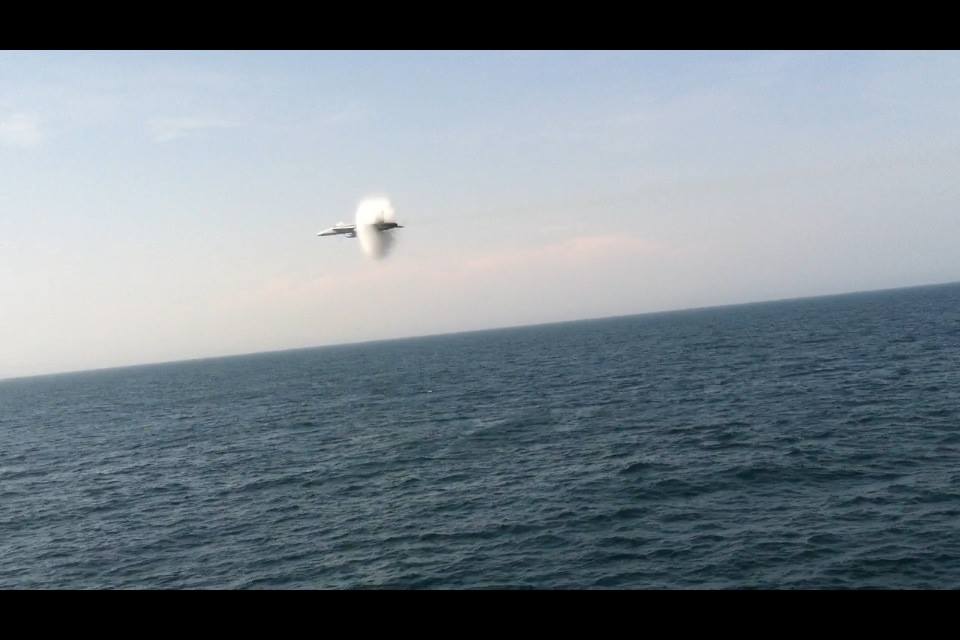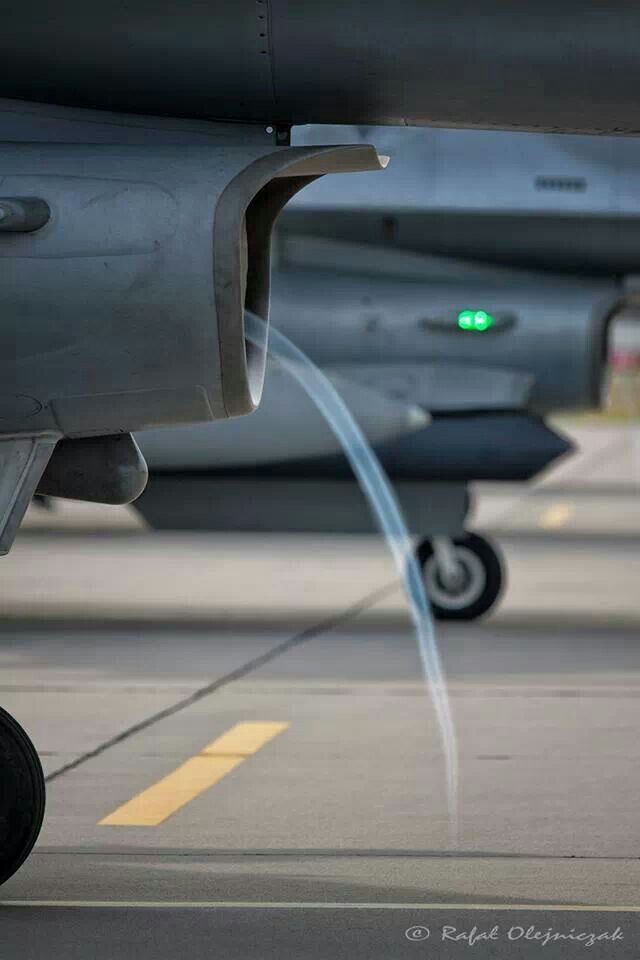It looks like you're using an Ad Blocker.
Please white-list or disable AboveTopSecret.com in your ad-blocking tool.
Thank you.
Some features of ATS will be disabled while you continue to use an ad-blocker.
5
share:

Sent to me and I can't explain.
Know the crew here will tell.
Thanks
a reply to: donlashway
No. Its got a really technical name, that I can never remember. Its caused by high humidity and low pressure caused by the aircraft.
I've seen it happen around P-3s, B-2s, 747s, and just about every other type out there. It's commonly mistaken to mean that the aircraft went supersonic though, but it doesn't.
No. Its got a really technical name, that I can never remember. Its caused by high humidity and low pressure caused by the aircraft.
I've seen it happen around P-3s, B-2s, 747s, and just about every other type out there. It's commonly mistaken to mean that the aircraft went supersonic though, but it doesn't.
It's a vapour cone.
The long name is Prandtl-Gauert Singularity.
The long name is Prandtl-Gauert Singularity.
A vapor cone, also known as shock collar or shock egg, is a visible cloud of condensed water which can sometimes form around an object. A vapor cone
is typically observed as an aircraft, or object, approaches transonic velocity. Atmospheric water then condenses, and thus becomes visible, as air
pressure varies suddenly across shock waves associated with supersonic flow speed.
Atmospheric condensation around aircraft is also associated with low-pressure regions in subsonic flight, and can typically be observed in damp conditions; but this does not result in conical condensation clouds.
Condensation cones appear in what was described as a Prandtl-Glauert singularity.[1] In addition to making the shock waves themselves visible, water condensation can also occur in the trough between two crests of the shock waves produced by the passing of the object. However, this effect does not necessarily coincide with the acceleration of an aircraft through the speed of sound or Mach 1
Atmospheric condensation around aircraft is also associated with low-pressure regions in subsonic flight, and can typically be observed in damp conditions; but this does not result in conical condensation clouds.
Condensation cones appear in what was described as a Prandtl-Glauert singularity.[1] In addition to making the shock waves themselves visible, water condensation can also occur in the trough between two crests of the shock waves produced by the passing of the object. However, this effect does not necessarily coincide with the acceleration of an aircraft through the speed of sound or Mach 1
a reply to: donlashway
A sonic boom is the sound associated with the shock waves created by an object traveling through the air faster than the speed of sound. Sonic booms generate enormous amounts of sound energy, sounding much like an explosion. The crack of a supersonic bullet passing overhead is an example of a sonic boom in miniature.
A sonic boom is the sound associated with the shock waves created by an object traveling through the air faster than the speed of sound. Sonic booms generate enormous amounts of sound energy, sounding much like an explosion. The crack of a supersonic bullet passing overhead is an example of a sonic boom in miniature.
a reply to: donlashway
A sonic boom is a noise. From Scientific American:
What you are seeing is the pressure wave from this phenomenon causing condensation. This plane is in the process of going supersonic.
A sonic boom is a noise. From Scientific American:
the propagation speed of sound waves is finite, sources of sound that are moving can begin to catch up with the sound waves they emit. As the speed of the object increases to the sonic velocity (the local velocity of sound waves), these sound waves begin to pile up in front of the object. If the object has sufficient acceleration, it can burst through this barrier of sound waves and move ahead of the radiated sound. The change in pressure as the object outruns all the pressure and sound waves in front of it is heard on the ground as an explosion, or sonic boom.
What you are seeing is the pressure wave from this phenomenon causing condensation. This plane is in the process of going supersonic.
edit on 13-6-2014 by ScientiaFortisDefendit because: (no reason given)
a reply to: Zaphod58
Thanks, he sent video too so cool.
It's great knowing answers are just a post away.
Thanks, he sent video too so cool.
It's great knowing answers are just a post away.
Prandtl-Glauert Cloud
GFDI: Cloud formation on adiabatic expansion
other imagesedit on 13-6-2014 by donlashway because: (no reason given)
a reply to: madmac5150
It was always fun going engine runs in those conditions. You always got a streamer of moisture going into the engine.
It was always fun going engine runs in those conditions. You always got a streamer of moisture going into the engine.
a reply to: donlashway
That actually caused, and still causes people to think the B-2 is supersonic, therefore has some exotic propulsion system.
That actually caused, and still causes people to think the B-2 is supersonic, therefore has some exotic propulsion system.
Very informative and interesting. Flag & star for ye for teaching me something new.
originally posted by: Zaphod58
a reply to: madmac5150
It was always fun going engine runs in those conditions. You always got a streamer of moisture going into the engine.
Watched many an F-16 engine run with moisture vortices running into that hoover of an intake... like tiny little tornados...

edit on 13-6-2014 by madmac5150 because: What difference does it make
a reply to: madmac5150
That one was always my favorite when conditions were right. Little beast though when it came to eating everything in sight, and quite a few things that weren't.
That one was always my favorite when conditions were right. Little beast though when it came to eating everything in sight, and quite a few things that weren't.
Hey, I grew up at McChord! Born on Fort Lewis though, dad was AF. Used to love going down to the flightline to watch all the heavies, F-15s and A-10s
take off. Good times. Small world huh?
originally posted by: madmac5150
a reply to: Zaphod58
I used to love watching the heavies land at McChord AFB in rain or high humidity... the entire top of the wing surfaces looked as though they were enveloped in a heavy fog. Really neat to watch...
originally posted by: Zaphod58
a reply to: madmac5150
It was always fun going engine runs in those conditions. You always got a streamer of moisture going into the engine.
Agreed, its always fun watching that little tornado. I love it when you do an engine spin after the aircraft has been idle for a while and the humidity is up a bit. The water vapor clouds that shoot out as two or three jets from the pneumatic starter can be quite spectacular, much like a smoke machine. I once watched a Styrofoam cup make a lazy entrance, propelled by the standard night time breeze across Botany Bay onto a run-bay with a 747 as we were running up on power. It made its way to the number two engine and a colleague and I knew what was about to happen and watched it pirouette then get sucked into the fan and diced into what appeared three perfectly equal longitudinal pieces. Funny how sometimes you just know its about to happen.
My favorite phenomena though is a weird cloud you sometimes see in the inlet of an engine on high power. I have seen it a few times and cant explain it. As the engine reaches power above about 80-85% and if the conditions are right, you will see a very slowly moving mist in the inlet that appears to defy both logic and the many cubic meters per second of air being pulled in. I have seen it both in the daytime and at night. It appears as a very slowly swirling mist that is best described as similar in look to a scanning laser through a smoke machine (a la, the opening scene in the movie Aliens inside Ripley's escape pod after it is found). It would appear to be some kind of strobe effect, although I cant explain how it manages to appear so still. Has anyone else here ever observed that?
LEE.
a reply to: thebozeian
Sounds like a St Elmos Fire type effect. I was on a -135 doing a power run that freaked out the ground guys because they had never seen it before.
Sounds like a St Elmos Fire type effect. I was on a -135 doing a power run that freaked out the ground guys because they had never seen it before.
new topics
-
Putin, Russia and the Great Architects of the Universe
ATS Skunk Works: 24 minutes ago -
A Warning to America: 25 Ways the US is Being Destroyed
New World Order: 4 hours ago -
President BIDEN's FBI Raided Donald Trump's Florida Home for OBAMA-NORTH KOREA Documents.
Political Conspiracies: 10 hours ago
top topics
-
President BIDEN's FBI Raided Donald Trump's Florida Home for OBAMA-NORTH KOREA Documents.
Political Conspiracies: 10 hours ago, 28 flags -
A Warning to America: 25 Ways the US is Being Destroyed
New World Order: 4 hours ago, 10 flags -
Gaza Terrorists Attack US Humanitarian Pier During Construction
Middle East Issues: 16 hours ago, 8 flags -
Las Vegas UFO Spotting Teen Traumatized by Demon Creature in Backyard
Aliens and UFOs: 15 hours ago, 6 flags -
2024 Pigeon Forge Rod Run - On the Strip (Video made for you)
Automotive Discussion: 16 hours ago, 4 flags -
Is AI Better Than the Hollywood Elite?
Movies: 12 hours ago, 3 flags -
Maestro Benedetto
Literature: 12 hours ago, 1 flags -
Putin, Russia and the Great Architects of the Universe
ATS Skunk Works: 24 minutes ago, 1 flags
active topics
-
Putin, Russia and the Great Architects of the Universe
ATS Skunk Works • 6 • : Lazy88 -
A Warning to America: 25 Ways the US is Being Destroyed
New World Order • 9 • : Lazy88 -
President BIDEN's FBI Raided Donald Trump's Florida Home for OBAMA-NORTH KOREA Documents.
Political Conspiracies • 21 • : CriticalStinker -
SETI chief says US has no evidence for alien technology. 'And we never have'
Aliens and UFOs • 75 • : Hecate666 -
Las Vegas UFO Spotting Teen Traumatized by Demon Creature in Backyard
Aliens and UFOs • 13 • : FlyersFan -
Mood Music Part VI
Music • 3105 • : BrucellaOrchitis -
The Acronym Game .. Pt.3
General Chit Chat • 7752 • : bally001 -
Is AI Better Than the Hollywood Elite?
Movies • 18 • : Hecate666 -
Hate makes for strange bedfellows
US Political Madness • 49 • : network dude -
Truth Social goes public, be careful not to lose your money
Mainstream News • 131 • : burritocat
5
